Soviet Circular Panorama.
|
Read more
at in70mm.com The 70mm Newsletter |
| Written by: Grigorij Shandorovich, Moscow, Russia | Date: 01.09.2009 |
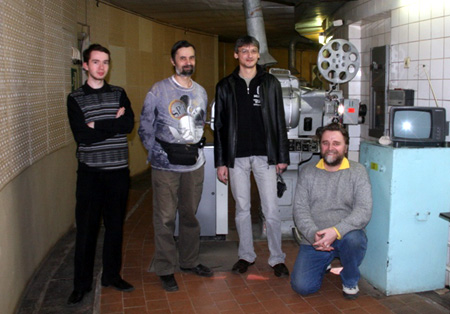 First
lifeguards of the Panorama First
lifeguards of the PanoramaOn the left - to the right: Alexander Zenin Author nearly all photography, videoinstaller. This is me, Grigoriy Peskov, former Master Field Engineer (1980-1990) of the panorama. Oleg Batyaev, Author of the site projectionist to Russia, cinema engineer. Aleksand YAvorskiy Acting master field engineer Cinematechnik. To begin with there is some theory. The image is formed of 11 segments (in the beginning was 22: 11 projectors and screens in two ranks, but it is short time). |
More
in 70mm reading: Soviet Circular Panorama - in Russian The true history of Circlorama 1962-65 Circlorama Theatre, Picadilly Circus, London, England Memories of Circlorama "Circlorama Cavalcade" credits Foreign 70mm Films in Russia Internet link: Kinopanorama Moscow Russian projectionist forum 1959 Circular Panaorama with 22 projectors Modern Circular Panorama with 11 projectors |
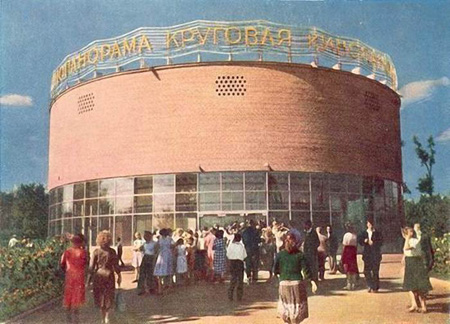 The
Panorama in 1959 The
Panorama in 195911 was chosen not for no reason - Circarama by Walt Disney has served as a prototype in which was 11х16mm, and we (in the USSR) have created 11х35mm. I don't know why, but projection frame rate of 25 fps has been chosen. Now, analyzing, I understand: most likely for simplification of editing and lip-sync by film manufacturer. |
Editor would like to thank Ilona Schioler, for
her help editing the Russian and English language texts. |
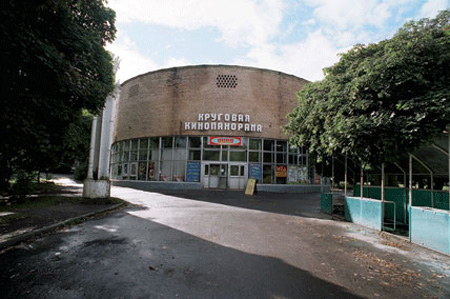 The
Panorama today The
Panorama today |
|
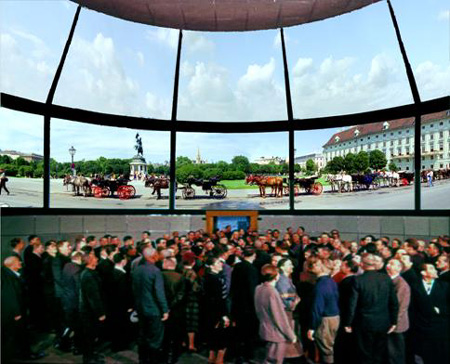 Circular
cinema with 22 screens. Two times 11 screens stacked upon each other Circular
cinema with 22 screens. Two times 11 screens stacked upon each otherDuring the trip across the USA, Chruschev has visited Circarama and has been admired by it. On arrival home, the secretary general has desired "to catch up and overtake" America and for three (3!) month we has been constructed Circular panorama! How many has left on designing and equipment manufacturing? I don't know. By calculations of our film experts (headed by the genius at cinema - professor Goldovskij), nine segments was quite enough. |
|
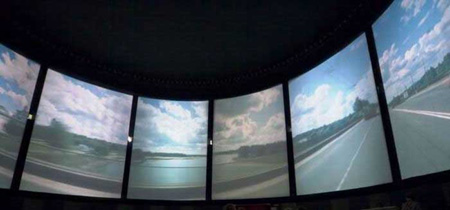 The Final variant with 11
screens The Final variant with 11
screensBut have chosen 11 - for compatibility with Circarama and an exchange of films with America. As a result - nothing did change back then. Moreover, later Circarama has passed on… guess… yes, a nine-segment variant. Even here two powers chased, well it was already history, in my opinion, the USSR likely was better off. But it is already exact not cinema. |
|
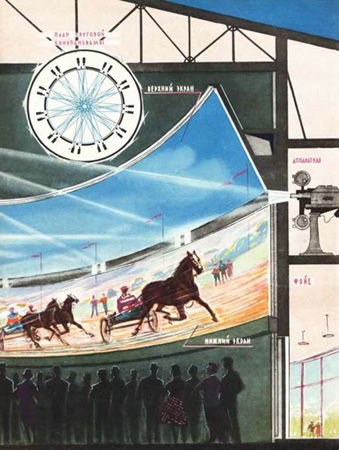 Russian
Circular panorama illustration in journal "Technology youth". Russian
Circular panorama illustration in journal "Technology youth".Now about panorama equipment. It is unique and has been made not in one complete set but in three! Except Moscow, the Circular panorama of the Soviet system has been installed in Prague (Czechoslovakia), Tokyo (Japan) and London (England)! In Prague the installation was only short lived, but in Japan the installation was working until the mid-1980s. An Englishmen have bought the patent, have constructed by own strength and showed the soviet films (as in those days only the powerful country could afford to shoot film on 11 wide-film movie cameras, equipping expeditions in all country, involving army, helicopters, aircraft, vessels and scale financial expenses). The most important thing in Circular panorama - synchronism, for which special units under the name rotasync (from "rotation" and "synchronisation" - rota + sync) are intended. But the main thing - all mechanisms are put in action by synchronous electric motors. |
|
Circular Panoramic projector |
|
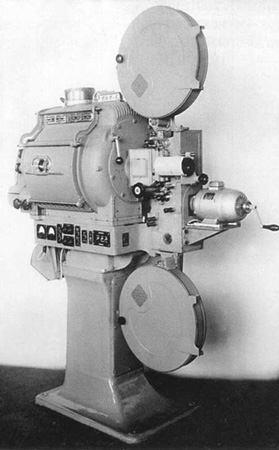 First
projector, the PKP-1 First
projector, the PKP-1For the second generation of circular panorama (the first it is not considered, have quickly refused it (in 4 years), having mounted anamorphic attachments and turned them on 90 degrees clockwise, having stretched thereby a picture on a vertical) under the special order of the country leaders, on LOMO (the Leningrad Optical-Mechanical Factory, nowadays the city of St. Petersburg) have been made devices of PKP-5 model (KPT-model based). Projection head moulding was too special: sound head was absent, but landing apertures under it there are not present. |
|
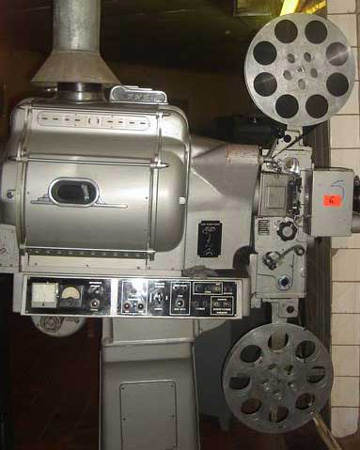 Xenon lamphouse (modernized 1986) PKP-5 Xenon lamphouse (modernized 1986) PKP-5One more important detail. Represent 22 devices (an initial variant) on coals (an arc lamp)? I do not represent. And the designer have not presented, or having presented - have refused at moment. The experimental xenon lighters (first in the USSR) also have mounted. Not so powerful (1000 w only), but more also is impossible: screens each other light and the strict balance of reasonable light exposure is necessary. |
|
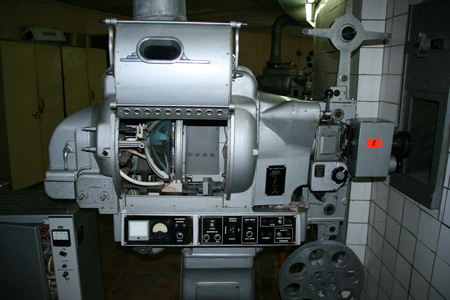 Xenon lamphouse (modernized 1986) PKP-5 Xenon lamphouse (modernized 1986) PKP-5Change is made under my participation torch since experimental 1 kvt lamphouse came to get fat badness. |
|
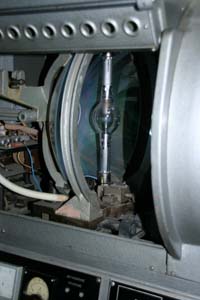 Xenon
lamp 3 kvt. Xenon
lamp 3 kvt.Works in mode ~ 1 - 1.5 kvt |
|
Rotasync Synchronisation |
|
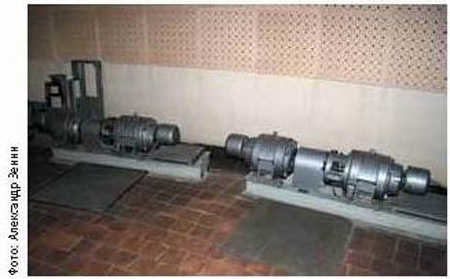 Rotasync Synchronisation. Rotasync Synchronisation.The synchronous engine (3-phases), therefore also synchronous that on each shift (change) of phases it moves on 1 step (1 step=60 degrees. From here - frequency of rotation=1750 rev/min under condition of 50 Hz in the industrial electric system). So far all is clear. BUT! At giving on such engine of pressure, it is started very sharply. It can lead to strong mechanical damages and equipment destruction. For the synchronous engine (and synchronous work of a panorama) "smooth start-up" is necessary synchronous. In it also are engaged Rotasync. These motor-generators transform 3-phase (120 degrees phase shift) an alternating current frequency of 50 Hz, to 3-phase alternating current with the frequency smoothly changing from 0 Hz to 50 Hz. |
|
 Programme
cabinet of Rotasync controls. Programme
cabinet of Rotasync controls.Here is how it occurs. Rotasync are dispersed from a industrial network to the synchronously standard turns. In this condition on their exit 220х3 frequency… 0 Hz! During this steady moment engines of devices (including 35-mm magnetic film reproducer) are connected to them. There is a minimum jerk, anchors rise in accurate position (roughly speaking, jerk is, but minimum - plus-minus of 29 degrees). After that rotasync start to brake smoothly at the expense of shunts to 0 turns (a full stop). Accordingly frequency smoothly grows about 0 Hz to 50 Hz. After a stop there comes the heaviest and critical moment - switching into a industrial electrical network at which corners of phases (phasing) NECESSARILY should coincide, differently occurs strong blow and equipment makes "caboom". |
|
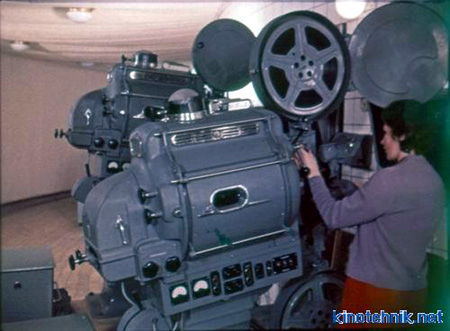 Projectors
of original 22-screen set-up Projectors
of original 22-screen set-up9 independent channels of sounding have been initially conceived! Simply smartly: 7 channels behind screens, 1 effects channel over a ceiling and 1 effects channel under a floor. Unfortunately, on a ceiling and in a floor channels have quickly failed and have been dismantled. Only 7 channels behind screens really work. |
|
Sound. A magnetic sound of 35-mm tape. |
|
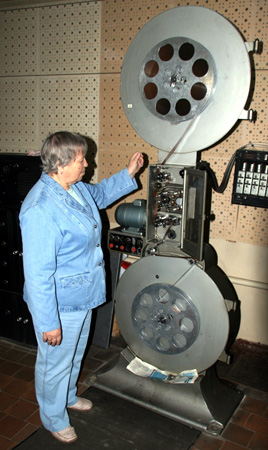 Near
by fonograf / sound dubber: The oldest emplyee of the Panorama since
the first day of operation, Lyudmila Pavlovna Vanjukova. Regrettably she
retired during the summer of 2008. Near
by fonograf / sound dubber: The oldest emplyee of the Panorama since
the first day of operation, Lyudmila Pavlovna Vanjukova. Regrettably she
retired during the summer of 2008. |
|
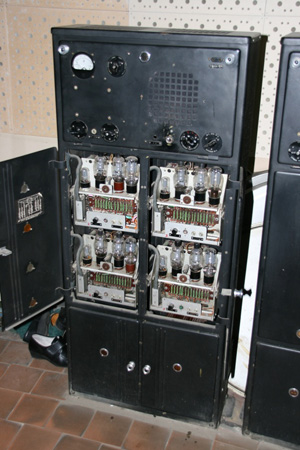 Amplifiers
from 1963 Amplifiers
from 1963 |
|
 Worn-out magnetic head Worn-out magnetic headFor sound reproduction it is used separate magnetic film reproducer (with synchronous engines too), which played a sound from a perforated 35-mm magnetic film. 9-channel magnetic heads, also made under the special order, are mounted on devices. |
|
Management. Technical management |
|
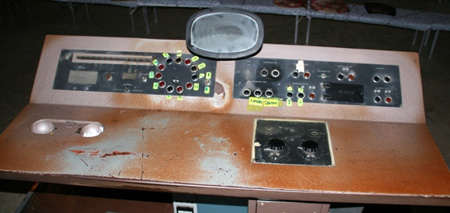 Projection
master console table Projection
master console tableAll film complex copes on-line from auditorium from a special control panel. The special film mechanic - the operator of the panel is engaged in film demonstration. |
|
 Repair
2-go device for Aleksand YAvorskiy Repair
2-go device for Aleksand YAvorskiyThe Repair is made by summer 2009. Will Repaired 2, the most spoiled device. Regrettably further work while they are stopped, by reason of problems with management owner Circular Panorama. |
|
 Films last 20 minutes, metric area of everyone - on the average 600 meters
(for one projector, in the sum - increase on 11). To a great regret,
newest of them was mad in 1993. At present Circular panorama
is in very poor technical and economic situation, but at the expense
of a handful of self-denying workers is live and works five days in a week! Films last 20 minutes, metric area of everyone - on the average 600 meters
(for one projector, in the sum - increase on 11). To a great regret,
newest of them was mad in 1993. At present Circular panorama
is in very poor technical and economic situation, but at the expense
of a handful of self-denying workers is live and works five days in a week!The collective of the Russian site of cinema technical workers carries out the action on technical rescue of it really a miracle of the world. On a course of restoration you we will inform in due time. |
|
 |
|
|
Go: back
- top - back issues
- news index Updated 21-01-24 |
|
